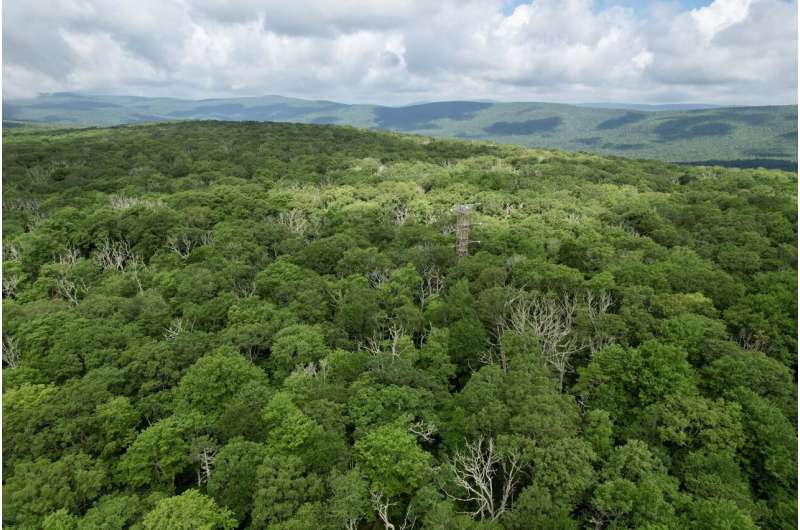This article has been reviewed according to Science X's editorial process and policies. Editors have highlighted the following attributes while ensuring the content's credibility:
fact-checked
trusted source
proofread
NASA to measure forest health from above

In places across the U.S., tree cover is shrinking—forests are burned by wildfires on the West Coast and drowned by rising sea levels along the East. From the ground, it's hard to assess the scale of the losses and the effects disappearing trees have on atmospheric carbon dioxide levels and climate change.
NASA research scientist Jon Ranson is working to improve new technologies for studying trees from above, so future Earth-observing missions can more accurately assess forest health.
"Trees do a huge service for the planet, in terms of sequestering carbon dioxide, taking it out of the atmosphere and putting it into wood," Ranson said, "but trees are very sensitive to our changing climate. We're trying to see the changes going on in forest ecosystems. If you detect things early enough, you might be able to do something about it."
When measured from aircraft and satellites, the wavelengths of light reflected by plants tell scientists about the amount of photosynthesis occurring, and therefore how much atmospheric carbon dioxide trees take up and store. The current standard for studying vegetation is called NDVI, or Normalized Differential Vegetation Index, which is the average of two broad portions of the infrared spectrum. NASA's NDVI record goes back 40 years, providing a low-resolution but accurate picture of forest health.
While NDVI is good at assessing vegetation quantity and vigor broadly, Ranson said, breaking down infrared and visible light into many more wavelengths, a technology called hyperspectral imaging, can provide insight on plants' water content, chlorophyll and even changes in health.
"Vegetation has these broad spectral properties," said Ian Adams, Earth Sciences Division Technologist at NASA's Goddard Space Flight Center. "With hyperspectral imaging, you get lots of different measurements at smaller, closer together frequencies. There is a lot more information we can pull out if we can get better spectral resolution."
By dramatically increasing the number of frequencies available for researchers to study, Ranson's work serves the priorities of the National Academies of Science's most recent Earth Science decadal survey, which determines the field's long-term priorities. The survey lists "surface topography and vegetation," including forests, as a key area of study in need of more advanced technology.
"Strategically for NASA, and more broadly for the remote sensing community, hyperspectral is one of the areas we see as the future," Adams said.
To make use of hyperspectral imaging by future orbital missions, data analysis techniques are first proven closer to the ground.
Ranson's team fitted a Skyfish drone (UAV) from partner institution Virginia Tech with a visible and infrared (VIS/IR) hyperspectral camera and lidar equipment. They flew the imaging equipment over forests near Blacksburg, VA, in a region called Mountain Lake. Comparing their UAV observations with actual CO2 levels recorded by sensors on a nearby National Ecological Observatory Network tower, Ranson's team was able to refine calculations about how much carbon the forest removed from the atmosphere.
These comparisons allowed them to further refine techniques for interpreting the hyperspectral data. For instance, Plants stressed by too much sunlight may release pigments to shield their chloroplasts, a condition his sensors can detect. If plants get too much shade, they may grow leaves with larger surface-areas, which can cause the sensor to overestimate plant productivity. Ranson wants to add short-wave infrared sensors to better distinguish reflections from leaves and other parts of plants, eliminating another possible source of error.
The view from space: Seeing the forest for the trees
Ranson's goal is to study forests on a global scale from space.
"We're trying to get the complete picture," Ranson said. "So that when we go to space, we know how to find the answer to the question, 'Are our forests healthy? And if not, why not?'"
Scientists and engineers at Goddard have been developing a mission concept called Concurrent Artificially intelligent Spectrometry and Adaptive Lidar System, or CASALS. If selected, CASALS would send a satellite with lidar and hyperspectral cameras into space. A constellation of such satellites could take the frequent measurements necessary to assess changes in forest productivity over time, using models perfected by Ranson's UAV flights.
"Forests take up as much carbon as the ocean does, yet forests cover only 9% of Earth's surface," said Ranson. "So, if something goes wrong with our forests, it's a dramatic issue. We've got this great, great resource in forests, and we need to care for them so they'll care for us."
Provided by NASA's Goddard Space Flight Center





















